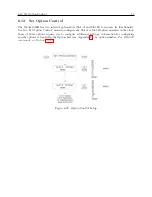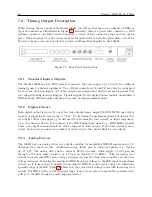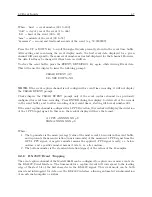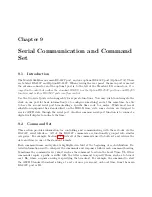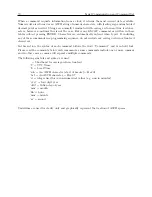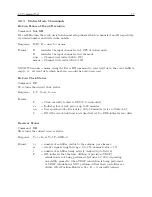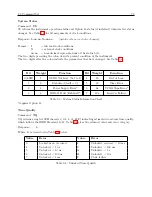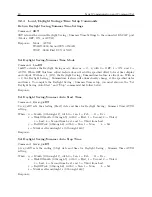
66
Relay Contacts and Event Inputs
8.2.3
Deviation Measurement
Both Channel A and B inputs can also be configured to display measured event times as 1 pulse-
per-second (1 PPS) deviation measurements. The intended purpose of the deviation measurement
function is to allow comparison of an external 1–PPS signal to the clock’s internal 1–PPS signal.
The clock determines the mean time difference between the two signals, which can be displayed on
the front panel or read via the RS-232 Interface.
8.2.4
Measurement Principle
The measurement technique employed for 1–PPS Deviation uses the same time determination and
recording scheme used for Event Time measurement (refer to paragraph above), but makes the
assumption that the input signal is periodic and continuous. Also, the operation of the circular
memory buffer is modified somewhat, in that recording does not stop after the first 200 events; new
Event Data is given priority over existing data, and will overwrite it. Since the incoming signal
is at 1 Hz and the circular buffer holds 200 events per channel, each Event Time Record will be
overwritten once every 200 seconds.
Once every second, the processor looks at the most recent group of 16 events. When computing
deviation, it uses only the portion of the event data describing fractional seconds (e.g. values
between 0.0000000 and 0.9999999 seconds). By normalizing the 16 fractional-second values around
0.0000000, the range of results from the deviation computations will be centered on zero (-0.4999999
to +0.5000000 seconds). Statistical computations are then performed on the 16 values to determine
their Mean and Sigma (Standard Deviation) values, which are then displayed on the front panel or
output via RS-232.
8.2.5
Event Timer Input Channel Configuration
In order for the Model 1088B to receive a timing input, adjustments to both the hardware and
software configuration may be required. The hardware configuration is described in Section 5.2.2.
8.2.6
Firmware Setup
Reconfiguration of the firmware may also be required to allow measurement and display of event
time data and/or 1–PPS deviation. See Section 6.9 and Figure 6.17 for detail on configuring the
event/deviation parameters from the front panel. See Section 9.2.2 for details on using the RS-232C
interface to manage event/deviation recording.
8.2.7
Displaying Data
Event and deviation data can be accessed from either the front panel or via RS-232 com-
mands. The following paragraphs describe the steps required to access data using the front panel
EVENT/DEVIATION key. Press the EVENT/DEVIATION key and the display will enter a circu-
lar scroll. It begins by showing the data (if any is present) for Channel A, as previously configured
for event recording in Figure 6.17 and Section 9.2.2. The readout will display one of the records
(001 to 200) and associated event times, using the following format:
CH A EVENT #nnn TIME
ddd:hh:mm:ss.sssssss
Содержание 1088A
Страница 4: ...iv ...
Страница 6: ...vi ...
Страница 18: ...xviii LIST OF FIGURES ...
Страница 23: ...1 4 Attaching Rack Mount Ears to 1088A B Series Clocks 3 Figure 1 2 Attaching Rack Mount Ears ...
Страница 24: ...4 Unpacking the Clock ...
Страница 32: ...12 Front and Rear Panels ...
Страница 38: ...18 Connecting Inlet Power Input and Output Signals ...
Страница 41: ...4 1 GPS Antenna Installation 21 Figure 4 2 Antenna Mounting Bracket Figure 4 3 Antenna Mounting with AS0044600 ...
Страница 46: ...26 GPS Antenna and Cable Information ...
Страница 48: ...28 Setting Internal Jumpers Figure 5 1 Model 1088B Main Board ...
Страница 76: ...56 The Setup Menus ...
Страница 112: ...92 Serial Communication and Command Set ...
Страница 127: ...B 4 Physical Dimensions 107 Figure B 1 Suggested Mounting of the AS0094500 Surge Arrester ...
Страница 128: ...108 Using Surge Arresters ...
Страница 137: ...C 5 Option 04 Parallel BCD Output 117 C 5 2 Option 04 Firmware Setup Figure C 2 Option 04 Firmware Setup ...
Страница 145: ...C 5 Option 04 Parallel BCD Output 125 Figure C 4 Option 04 Output Jumper Settings ...
Страница 146: ...126 Options List Figure C 5 Option 04 Board Layout and Jumper Locations ...
Страница 165: ...C 12 Option 17 Parallel BCD Output and Second RS 232 Port 145 Figure C 11 Option 17 Output Jumper Settings ...
Страница 166: ...146 Options List Figure C 12 Option 17 Board Layout and Jumper Locations ...
Страница 176: ...156 Options List C 14 5 Typical Network Configuration Figure C 15 Option 18 Network Configuration ...
Страница 187: ...C 16 Option 20A Four Fiber Optic Outputs 167 Figure C 22 Option 20A Jumper Locations ...
Страница 194: ...174 Options List Figure C 24 Option 23 Internal Jumper Setup ...
Страница 196: ...176 Options List Figure C 25 Option 27 Jumper Locations ...
Страница 214: ...194 Options List Figure C 28 Option 29 Connector Signal Locations ...
Страница 270: ...250 Options List ...




